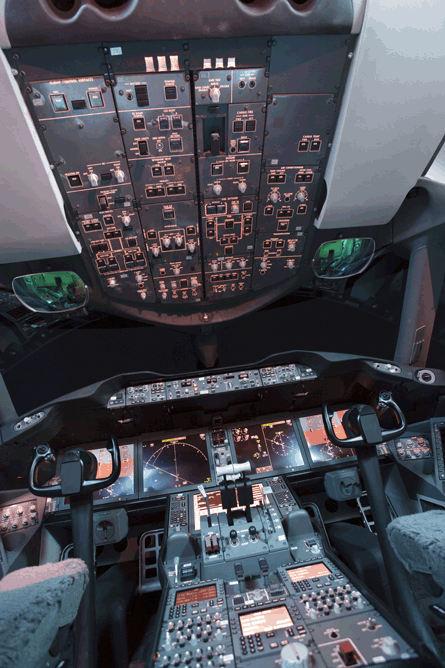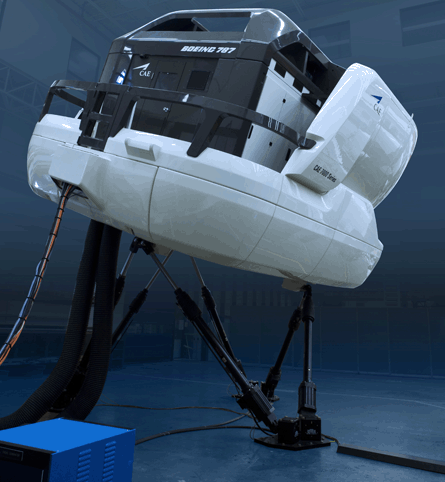 |
|---|
© CAECAE has been building 787 simulators for launch customers including Japan Airlines |
The Canadian manufacturer offered a brief window of opportunity at its Montreal facility to allow Flight International a chance to preview is rendition of the 787. Still on the production floor was a CAE 7000 series simulator configured as a 787 with General Electric GEnx-1B engines. The simulator was being built for Continental Airlines, Boeing's domestic 787 launch customer.
Continental is buying both -8 and -9 variants, and the simulator was configured as a 787-8 with 70,000lb-rated thrust (311kN). While by design the simulator is supposed to feel just like the real thing, my subjective comments on how the "787" flew and felt are clearly only reflective of CAE's simulator.
Visual cues are an essential part of piloting and its simulation. Continental is to use a Rockwell Collins visual display for its 787 simulator. Tactile cues also play a significant role. As with the Airbus A330 simulator, the 787 has CAE's True Electric Motion system.
Developed in co-operation with Moog, the all-electric system promises smooth and quiet articulation. In an added nod to efficiency, it requires just 25% of the power needed to run a comparable hydraulic actuation system.
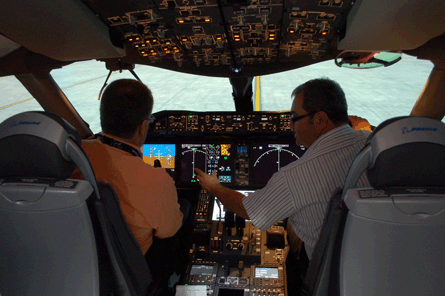 |
|---|
© Jon Ostrower/FlightglobalTest pilot Mike Gerzanics in the Boeing 787 flight simulator |
Entering the simulator cab, I was impressed by the size and layout of the instructor station. The instructor screens can be moved so that the instructor can face forward and better observe the session. The entire session can be recorded, allowing for playback of selected manoeuvres for enhanced debrief and learning. Additionally, a video camera can record the actual crew actions during the simulation session.
MIDSIZED FLIGHTDECK
My initial impression of the flightdeck was that its size was on a par with a 757. Cockpit colour is a blueish grey, which I found more refreshing than Boeing's previous light brown. The six flightdeck windows have a combined area of 3.1m2 (33.4ft2), markedly larger than the 777's 2.5m2. Cockpit layout is classic Boeing, a space where any 777 pilot would feel right at home. Two welcome additions to the flightdeck are the electronic flight bags, located on the sidewalls and the Rockwell Collins head-up displays. The forward panel is highlighted by five 15.1in (38.3cm) multifunctional displays, two per side with one on the centre console. Conventional control columns actuate the full fly-by-wire flight controls. The two thrust levers fall readily to hand. As with other Boeing offerings, the thrust levers are back-driven, giving valuable feedback to the pilots when the autothrottles are in use.
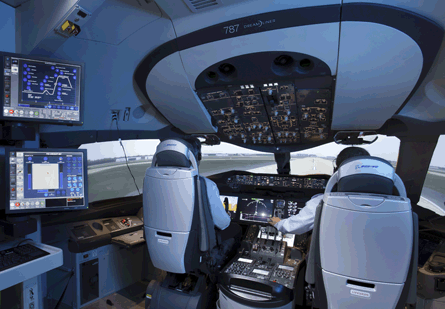 |
|---|
© CAEThe forward panel is highlighted by five multifunctional displays. Overhead are system operation panels |
As with the 777, the overhead panel contains system operation panels. Conspicuous by it absence is a "pneumatic" panel. The 787 is a more electric aircraft, and the electric control panel's size reflect its increased importance.
The electrical system has six generators: two 250kVA ones on each engine and two 225kVA units on the auxiliary power unit. The engine ones are starter/generators, as there is no bleed air to start them. The 787 retains three hydraulic systems, just as the 777 does, but they operate at 345bar (5,000lb/in2) versus the 777's 207bar units. The higher operating pressure of the system allows for a lighter and more compact system.
The left and right systems have an engine-driven pump and an electric demand pump. The centre system is powered by two 30GPM electric pumps; one runs throughout the flight with the other operating at high-demand times such as when the landing gear is raised or lowered. Like the 777, the 787 has a ram air turbine. In an emergency situation the turbine is deployed and can pressurise the centre hydraulic system as well as provide electrical power to the essential electrical bus.
ENHANCED GLASS
The five large multifunction displays provide 0.35m2 (3.79ft2) of display space, more that twice that of the 777. The four forward panel mounted displays nearly cover the entire instrument panel. The outboard displays are typically configured as primary flight displays, the top half being an attitude direction indicator with surrounding airspeed and altitude tapes and the bottom half a horizontal situation indicator.
The primary displays only occupy the inboard two-thirds of the display space; the outboard third is configured as an auxiliary display. This is divided in two, the top being a flight data block and the lower half a message block for air traffic control and company uplinks. The two inboard multifunction displays show map data as well as engine indication crew alerting.
System synoptics as well as the smart electronic checklists can also be displayed. One nice addition is the vertical situation display. Occupying the lower third of the multifunction display, this enhances situational awareness by graphically depicting current aircraft altitude, desired vertical path as well as a terrain profile line.
The centre multifunction display, on the pedestal, is usually configured as two flight management system control display units. The CDUs are not touchscreen nor are there bezel-mounted buttons. Data entry is accomplished via two centre console mounted multifunction keypads. Additionally, there are two pad type cursor control devices. The CCDs are similar to those of the 777, and their operation is intuitive.
Unlike the cursor in Dassault's EASy flightdeck, the cursor cannot be jumped from display to display by moving it to the edge of a display. Three buttons on the top of the CCD move the cursor between displays, a workable but less elegant solution than that offered by EASy. Interfacing with the CDUs was a challenge at first, since data is entered via the multifunction keypad and the CCD.
Nevertheless, the FMS software is set up to ease the data entry process by automatically stepping the entry box to the next logical position. What I found useful is that the tuning control panel is on the centre pedestal. This panel, similar to those found in numerous other avionics systems, replaces the individual radio control heads found on the 777.
The sidewall-mounted Class 3 electronic flight bags represent a step in the right direction for a truly paperless cockpit. These standalone items are independent of the multifunction displays and cannot show own-ship position.
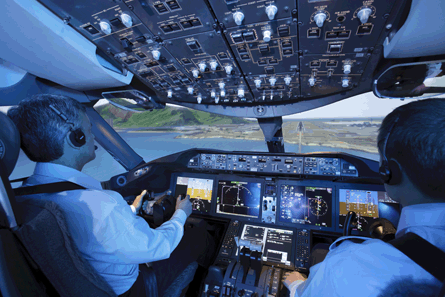 |
|---|
© CAEThe Continental simulator was configured as a 787-8 with 70,000lb-rated thrust |
Additionally, their placement on the cockpit sidewall is less than optimal. One neat feature of the multifunction display's map is that at ranges of less than 5nm (9.2km), when on the ground, an airport diagram is displayed along with current own-ship position. This capability will no doubt increase positional awareness during night and low visibility conditions.
While Boeing's decision to place EFB information on standalone displays is no doubt driven by regulatory concerns, a fully integrated system using the several large multifunction displays might have been a more seamless solution.
Dual head-up displays are 787 standard equipment. The Rockwell Collins displays use liquid crystal on silicon LCD projection technology. The HUDs have a 36 x 30° field of view with a 60Hz update rate. The addition of a HUD to the flightdeck brings numerous benefits, especially at airports where the 787's Cat IIIB autoland capability cannot be used.
The safety of visual approaches should be enhanced, as the approach can be flown entirely heads up. Future implementation of an enhanced vision capability for the 787 would be greatly eased with an approved HUD already installed.
HOW IT "FLIES"
I am type rated in both the 777 and 757/767, having flown them in engineering and maintenance capacity for a US legacy carrier. While it has been several years since my last flight in either type, I instantly felt at home in the 787. For my familiarisation preview flight of the 787 simulator, the empty weight was 113,500kg (250,000lb) and a fuel load of 68,000kg. The simulator was at San Francisco International, an airport with which I am familiar. CAE Capt Domenic Di Iorio sat in the right seat and guided me through the pre-start flows. Di Iorio also ran the electronic checklist.
By design, flows and procedures are similar to those I remember for the 777. While we typically would start both engines on the 777 at the same time, we started No 2 followed by No 1 in the 787 simulator. Regardless, the procedure is simple - start switch to start and start lever to on, the FADEC taking care of the rest. Flaps were set to 5, and the before-taxi checklist was accomplished using the smart electronic checklist.
During the taxi to Runway 28R I again marvelled at level of detail in the simulation. While never to be confused with the real thing, feeling concrete expansion joints while taxiing lends an air of authenticity. A reduced power take-off was accomplished, with indicated take-off speeds (V1/VR/V2) of 142/144/153kt respectively.
Rotation forces were on par with those I remembered from the 777, establishing a 10e_SDgr attitude and holding it until lift-off. Once airborne the gear was retracted and I followed the flight director guidance for the initial climb. Passing 1,000ft (300m) MSL the flaps were retracted at the reference flap speed bugs on the airspeed tape. A 250kt indicated airspeed climb to 5,000ft MSL was accomplished, and I steered the 787 towards the coast near Half Moon Bay, California.
Once level at 5,000ft I did a series of 45° angle of bank turns. During these manoeuvres I found the control forces were reminiscent of the 777, the large craft a joy to manoeuvre.
Many, myself included, would argue that Boeing got it right with the 777 with regard to handling qualities. For the 787, Boeing has built upon the flight-control laws developed for the 777. In the pitch axis the 777 uses a scheme called C*u, which is a blended g rate and pitch rate command system. At high speeds the control column commands a g rate, with neutral being 1g. At slow speed the control column commands a desired pitch rate.
|
|
|---|
© CAE |
With Boeing's implementation of this scheme, the aircraft has apparent speed stability, just as any conventional light aircraft does. For the 787 Boeing has also elected to use a C*u scheme.
For lateral-directional (roll-yaw) control, Boeing has again taken a slightly different path to obtain outstanding handling qualities for the 787. In the 777, movement of the yoke and rudder pedals commands proportional displacement of the ailerons (+ roll spoilers) and rudder. Control surface deflection is a function of aircraft speed and yoke/rudder input magnitude.
ROLL AXIS
Boeing did incorporate some active protections in the roll axis. At bank angles less than 35°, the 777 will hold a bank angle with no yoke input. To hold a bank angle above 35°, the yoke must be displaced. Releasing the yoke from a large bank angle will allow the aircraft to return to and hold a 35° bank angle. The 787 is no different in this regard, but its roll control scheme when airborne is a roll rate command one. On the ground, however, yoke movement commands aileron (+ roll spoiler) deflection.
In the yaw axis there are major differences in the 787's control scheme from the 777. On the ground when speed is below 60kt (110km/h), the rudder pedal movement commands rudder deflection, direct law in Airbus parlance. Above 60kt, rudder pedal movement commands a yaw rate.
Once airborne, rudder pedal movement commands angle of side slip. In a conventional control aircraft, side slip will generate a roll in the same direction as the pedal input: left rudder will cause the left wing to drop. Pilots expect some roll due to yaw, and the 787 does exhibit this characteristic while airborne.
After completing my brief familiarisation of the 787's up and away handling qualities, as evidenced by the CAE simulator, we returned to San Francisco for a visual approach to Runway 28R. The flaps were set to 30, a setting familiar to any 777 pilot. I disconnected the autothrottles and used the HUD to manually fly the approach.
Flying the approach is best described as easy. The HUD's flightpath vector ensured I held the desired aim point. Engine response on final was good, allowing accurate tracking of the target airspeed. There was no crosswind for my landing, the 787 touching down on the runway centreline in a wings level attitude. I used the toe-actuated wheel brakes and reverse engine thrust to stop the aircraft on the runway.
Di Iorio reset the simulator, placing us at the approach end of Runway 1L at San Francisco. With 58,800kg of fuel, the take-off gross weight was 172,250kg. Ambient temperature was 15° (59°), and V indicated airspeeds were now 138/140/149kt.
Once we were rolling down the runway I pressed the TOGA button on the thrust lever, the autothrottle smartly advancing both engines to a reduced N1 setting of 92.5%. Just after reaching an indicated airspeed of 138kt, Di Iorio failed the left engine.
Sensing the yaw, I put in right rudder to keep the 787 tracking down the runway. Once airborne with the gear retracted I put in rudder trim to neutralise the pedal forces. Levelling at 2,000ft MSL, I disconnected the autothrottle and hand-flew the aircraft to a downwind leg for an approach to Runway 28R. On the downwind leg I centred the rudder trim, allowing the 787's ITACS system to keep the aircraft in co-ordinated flight with the asymmetric thrust condition.
The 777 has TACS, which stands for thrust asymmetry compensation system. TACS is a standalone system that can be disabled by the pilot and uses asymmetric thrust levels to command a rudder input. In my experience flying the 777, I found TACS to be a great aide in engine-out approaches during simulator training and evaluation sessions. While performing post maintenance flights in the actual aircraft, the TACS maintained co-ordinated flight as we shut down and re-lit engines.
ITACS stands for Improved TACS, but it is not a standalone system in the 787, it is resident in the flight-control logic. Airbus commercial fly-by-wire aircraft all have benign engine-out flight characteristics, an inherent feature of their flight-control laws response to asymmetric engine thrust. ITACS raises this characteristic to an even higher level, seamlessly manipulating the rudder to keep co-ordinated flight as asymmetric thrust levels vary.
To better keep the pilot in the loop, the rudder pedals are back-driven to track rudder displacement. As with the 777, the 787's autothrottle can be engaged on the good engine, allowing for automated speed management even during a single-engine approach.
My last approach was an engine-out hand-flown instrument landing system approach to Runway 28R with the autothrottle off. As with my first approach, I used the HUD to fly the manoeuvre. Flaps were selected to 20 for the approach, the same setting used for an engine-out approach in the 777.
As I varied the thrust on final, I could feel the rudder pedals move as the ITACS kept the 787 in trim. With all this help, flying the engine-out approach was easy. Once stopped on the runway centreline, Di Iorio reset the simulator to a gate and turned off the motion.
SIMULATED DREAMLINER
During my 2h in the 787 simulator I was impressed by a number of things. First, I continue to be amazed by the increasing levels of realism offered by current generation simulators. As with my earlier report on CAE's A330 simulator, I found the electric motion system on the 787 simulator provided the smooth and quiet articulation necessary for realistic simulation. The Rockwell Collins visual display system was outstanding, if not quite as sharp as the Tropos 6000 system I experienced in my earlier A330 flight.
As a window into the 787 flightdeck, it shows that Boeing is comfortable offering incremental improvements to its successful 777 series of aircraft as it sought to make the 787 as common with the 777 as it could.
Perhaps I am old school when it comes to transport aircraft design, but while the debate over sidestick versus control column continues, I am more comfortable with the latter. That Boeing continues to offer back-driven thrust levers and rudder pedals shows it is still committed to keeping the pilot in the loop.
I found the standard HUD to be a wonderful addition to the 787's cockpit, a tool whose utility will only increase over the life of the aircraft. As a type-rated 777 pilot I felt instantly at home in the 787 simulator cockpit. If the 787 flies as well as CAE's simulator portends, Boeing has built yet another pilot's aircraft that will elicit fond memories for years to come.
Source: Flight International





















